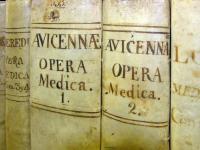The Library consists of several spaces, located on two floors. On the first floor, you will find the reading room for the general public, the director's office and a warehouse. On the second floor, the researchers room, the training room and three warehouses.
The Library’s collection collects historical and modern collections from different scientific areas: medicine, astronomy, physics, chemistry, botany, geology, although addressed from a historical perspective. Most of the works are housed in warehouses. There are only some reference works in the rooms. Except for modern monographs and the audiovisual material, which are lendable, the other are reference materials in room.
The Library has a collection of modern and old journals, especially relevant for the medicine history of the second half of the 19th century.
Holdings
Library of the History of Medicine and Science
It contains a collection of monographs on the subject comprising over 10,000 volumes, a collection of the most important specialist journals in this area and a section of reference works with over 1,000 titles. Prominent among its holdings is the Peregrín Casanova donation, containing a large collection of Darwinist texts.
Historical Medical Library
 It has total holdings of over thirty thousand volumes, including some 3,000 medical books dating from the sixteenth to the eighteenth centuries and around 15,000 from the nineteenth and twentieth, as well as important collections of journals from the 1700s and 1800s. Its original nucleus was the old collections of the University of Valencia’s Faculty of Medicine Library, which have subsequently been supplemented over the past hundred years and more by a continual succession of donations from doctors in Valencia and other parts of Spain. Among the earliest of these are outstanding contributions from two nineteenth-century figures: that of León Sánchez Quintanar, notable for its wealth of valuable copies of Renaissance and Baroque books, and that of Enrique Ferrer Viñerta, primarily on surgery.
It has total holdings of over thirty thousand volumes, including some 3,000 medical books dating from the sixteenth to the eighteenth centuries and around 15,000 from the nineteenth and twentieth, as well as important collections of journals from the 1700s and 1800s. Its original nucleus was the old collections of the University of Valencia’s Faculty of Medicine Library, which have subsequently been supplemented over the past hundred years and more by a continual succession of donations from doctors in Valencia and other parts of Spain. Among the earliest of these are outstanding contributions from two nineteenth-century figures: that of León Sánchez Quintanar, notable for its wealth of valuable copies of Renaissance and Baroque books, and that of Enrique Ferrer Viñerta, primarily on surgery.
Among the twentieth-century donations the most prominent is that of the psychiatrist and medical historian Vicente Peset Llorca (Seville, 1914–Valencia, 1981), after whom the Institute’s library is named, and whose works notably include his studies of the Valencian medical circles around Gregorio Mayans, collected in his books Mayáns y los médicos [Mayans and the Doctors] (1972) and Gregori Mayans i la cultura de la Il.lustració [Gregori Mayans and the Culture of the Enlightenment] (1975). After his death, his brother Juan Peset Llorca donated his library to the Institute, including his research files, papers and notes.
Historical Library of the University of Valencia Astronomical Observatory
 The present Observatory was founded in 1909 by Ignacio Tarazona y Blanch (1859-1924), Professor of Cosmography and Geophysics at the University of Valencia. The library, which is wide-ranging in its subject matter, contains works on astronomy, mathematics, history, natural sciences, teaching, grammar, etc., particularly from the nineteenth and twentieth centuries, some of which include notable engravings. It consists of the books and journals acquired by the Observatory and Tarazona’s personal library, bequeathed to the university after his death.
The present Observatory was founded in 1909 by Ignacio Tarazona y Blanch (1859-1924), Professor of Cosmography and Geophysics at the University of Valencia. The library, which is wide-ranging in its subject matter, contains works on astronomy, mathematics, history, natural sciences, teaching, grammar, etc., particularly from the nineteenth and twentieth centuries, some of which include notable engravings. It consists of the books and journals acquired by the Observatory and Tarazona’s personal library, bequeathed to the university after his death.
Rodrigo Pertegás Archive
This archive comprises part of the vast body of work carried out by the doctor and researcher José Rodrigo Pertegás (1854-1927) in a number of different archives in the city of Valencia, where he devoted himself to summarising and copying a great variety of documentation, including every kind of data referring to medicine (biographical and bio-bibliographical data, epidemics, issues related to public health, the medical profession and medical practice in Valencia, etc.). Thus his papers contain historico-medical information both from archives that are perfectly accessible nowadays, such as the Archive of the Kingdom of Valencia (Archivo del Reino) or the Municipal Archive, and from others that are now lost, as in the case of the parish archives.











